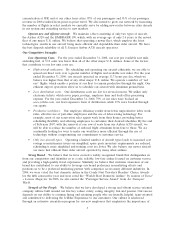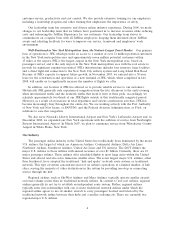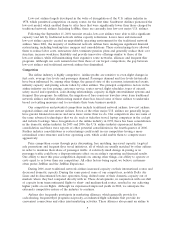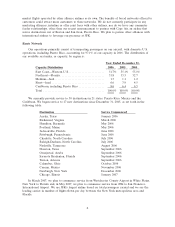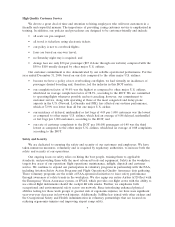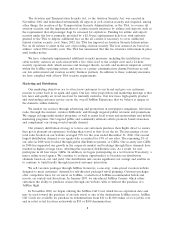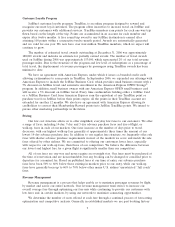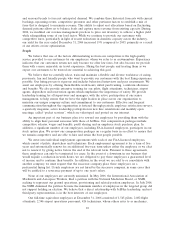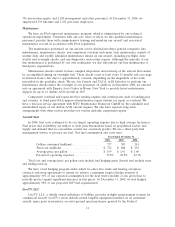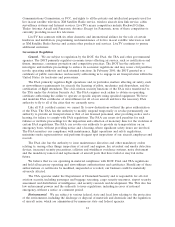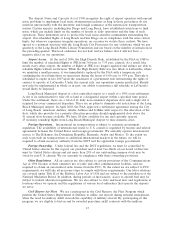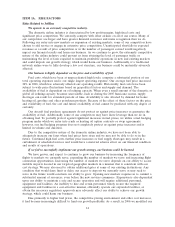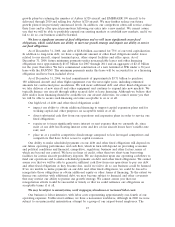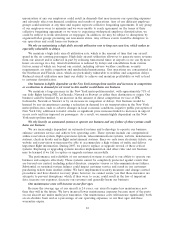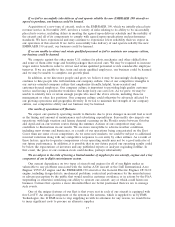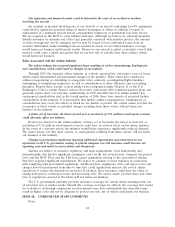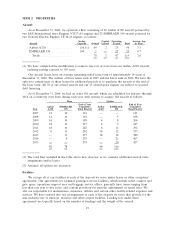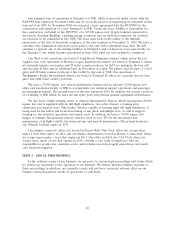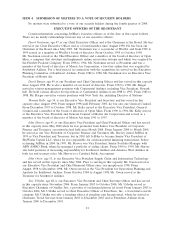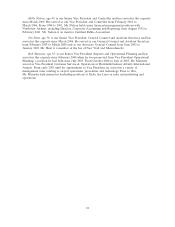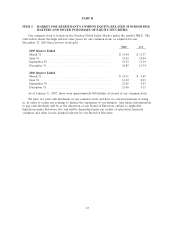JetBlue Airlines 2006 Annual Report Download - page 23
Download and view the complete annual report
Please find page 23 of the 2006 JetBlue Airlines annual report below. You can navigate through the pages in the report by either clicking on the pages listed below, or by using the keyword search tool below to find specific information within the annual report.The Airport Noise and Capacity Act of 1990 recognizes the right of airport operators with special
noise problems to implement local noise abatement procedures as long as those procedures do not
interfere unreasonably with the interstate and foreign commerce of the national air transportation
system. Certain airports, including San Diego and Long Beach, have established restrictions to limit
noise, which can include limits on the number of hourly or daily operations and the time of such
operations. These limitations serve to protect the local noise-sensitive communities surrounding the
airport. Our scheduled flights at Long Beach and San Diego are in compliance with the noise curfew
limits, but when we experience irregular operations, on occasion we violate these curfews. We have
agreed to a payment structure with the Long Beach City Prosecutor for any violations, which we pay
quarterly to the Long Beach Public Library Foundation and are based on the number of infractions in
the preceding quarter. This local ordinance has not had, and we believe that it will not have, a
negative effect on our operations.
Airport Access. At the end of 2006, the High Density Rule, established by the FAA in 1968 to
limit the number of scheduled flights at JFK from 3:00 p.m. to 7:59 p.m., expired. As a result, like
nearly every other airport, the number of flights at JFK is no longer regulated and airlines are able to
schedule flights without restrictions. While the High Density Rule was also lifted at LaGuardia, where
we maintain a small presence, it was immediately replaced by the FAA with a temporary rule
continuing the strict limitations on operations during the hours of 6:00 a.m. to 9:59 p.m. This rule is
scheduled to expire in late 2007 upon the enactment of a permanent rule restructuring the rights of
carriers to operate at LaGuardia. Under the current rule, our operations remain unaffected. Should
new rules be implemented in whole or in part, our ability to maintain a full schedule at LaGuardia
would likely be impacted.
Long Beach Municipal Airport is a slot-controlled airport as a result of a 1995 court settlement.
A slot is an authorization to take off or land at a designated airport within a specified time period.
Under the settlement, there are a total of 41 daily non-commuter departure slots and a single slot is
required for every commercial departure. There are no plans to eliminate slot restrictions at the Long
Beach Municipal Airport. In April 2003, the FAA approved a settlement agreement among the City
of Long Beach, American Airlines, Alaska Airlines and JetBlue with respect to the allocation of the
slots, which also provides for a priority allocation procedure should supplemental slots above the
41 current slots become available. We have 28 slots available for use and currently operate
25 weekday roundtrip flights from Long Beach Municipal Airport to nine domestic cities.
Foreign Operations. International air transportation is subject to extensive government
regulation. The availability of international routes to U.S. carriers is regulated by treaties and related
agreements between the United States and foreign governments. We currently operate international
service to The Bahamas, the Dominican Republic, Bermuda, Aruba and Mexico. To the extent we
seek to provide air transportation to additional international markets in the future, we will be
required to obtain necessary authority from the DOT and the applicable foreign government.
Foreign Ownership. Under federal law and the DOT regulations, we must be controlled by
United States citizens. In this regard, our president and at least two-thirds of our board of directors
must be United States citizens and not more than 25%of our outstanding common stock may be
voted by non-U.S. citizens. We are currently in compliance with these ownership provisions.
Other Regulations. All air carriers are also subject to certain provisions of the Communications
Act of 1934 because of their extensive use of radio and other communication facilities, and are
required to obtain an aeronautical radio license from the FCC. To the extent we are subject to FCC
requirements, we will take all necessary steps to comply with those requirements. Our labor relations
are covered under Title II of the Railway Labor Act of 1926 and are subject to the jurisdiction of the
National Mediation Board. In addition, during periods of fuel scarcity, access to aircraft fuel may be
subject to federal allocation regulations. We are also subject to state and local laws and regulations at
locations where we operate and the regulations of various local authorities that operate the airports
we serve.
Civil Reserve Air Fleet. We are a participant in the Civil Reserve Air Fleet Program which
permits the United States Department of Defense to utilize our aircraft during national emergencies
when the need for military airlift exceeds the capability of military aircraft. By participating in this
program, we are eligible to bid on and be awarded peacetime airlift contracts with the military.
13


